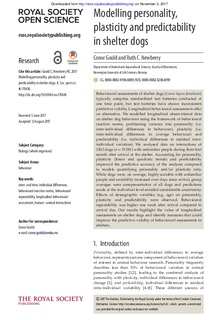Modelling personality, plasticity and predictability in shelter dogs
Journal article, Peer reviewed
Accepted version
Permanent lenke
http://hdl.handle.net/11250/2468713Utgivelsesdato
2017Metadata
Vis full innførselSamlinger
Sammendrag
Behavioural assessments of shelter dogs (Canis lupus familiaris) typically comprise standardized test batteries conducted at one time point, but test batteries have shown inconsistent predictive validity. Longitudinal behavioural assessments offer an alternative. We modelled longitudinal observational data on shelter dog behaviour using the framework of behavioural reaction norms, partitioning variance into personality (i.e. inter-individual differences in average behaviour), plasticity (i.e. intra-individual differences in behaviour) and predictability (i.e. individual differences in residual intra-individual variation). We analysed data on interactions of 3263 dogs (n = 19 281) with unfamiliar people during their first month after arrival at the shelter. Accounting for personality, plasticity (linear and quadratic trends) and predictability improved the predictive accuracy of the analyses compared to models quantifying personality and/or plasticity only. While dogs were, on average, highly sociable with unfamiliar people and sociability increased over days since arrival, group averages were unrepresentative of all dogs and predictions made at the individual level entailed considerable uncertainty. Effects of demographic variables (e.g. age) on personality, plasticity and predictability were observed. Behavioural repeatability was higher one week after arrival compared to arrival day. Our results highlight the value of longitudinal assessments on shelter dogs and identify measures that could improve the predictive validity of behavioural assessments in shelters. Keywords: inter- and intra-individual differences, behavioural reaction norms, behavioural repeatability, longitudinal behavioural assessment, human–animal interactions

